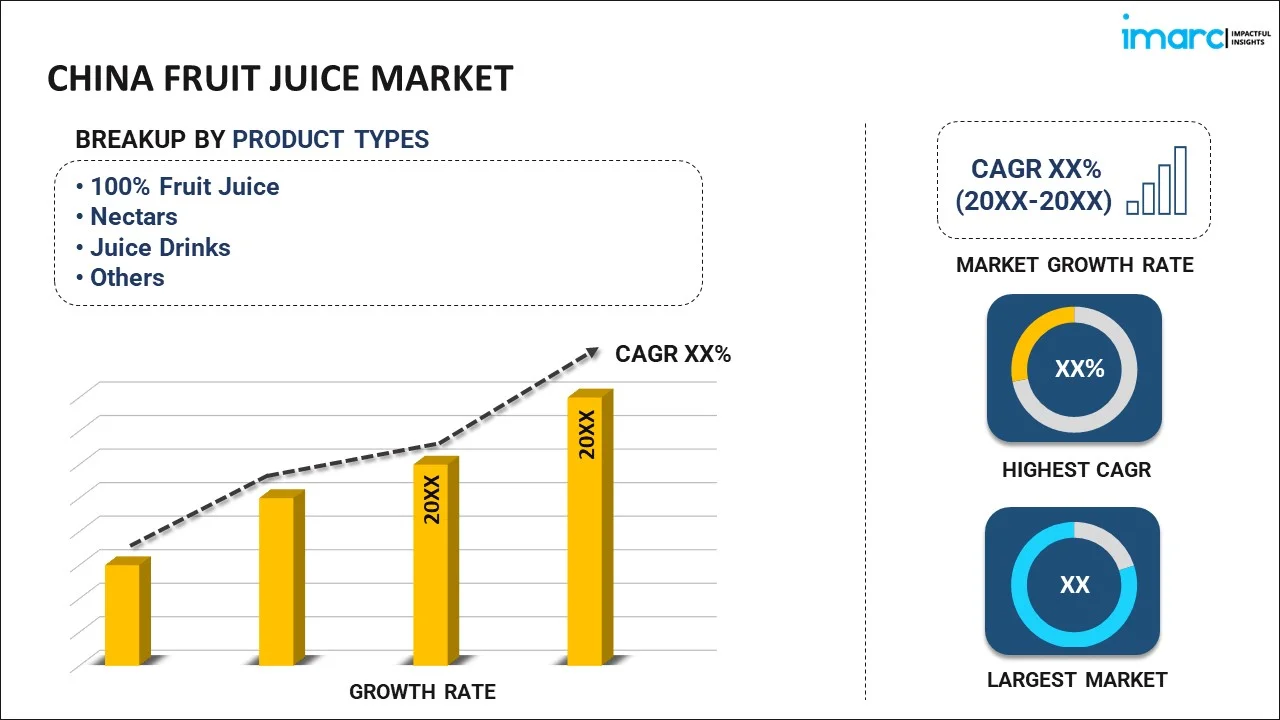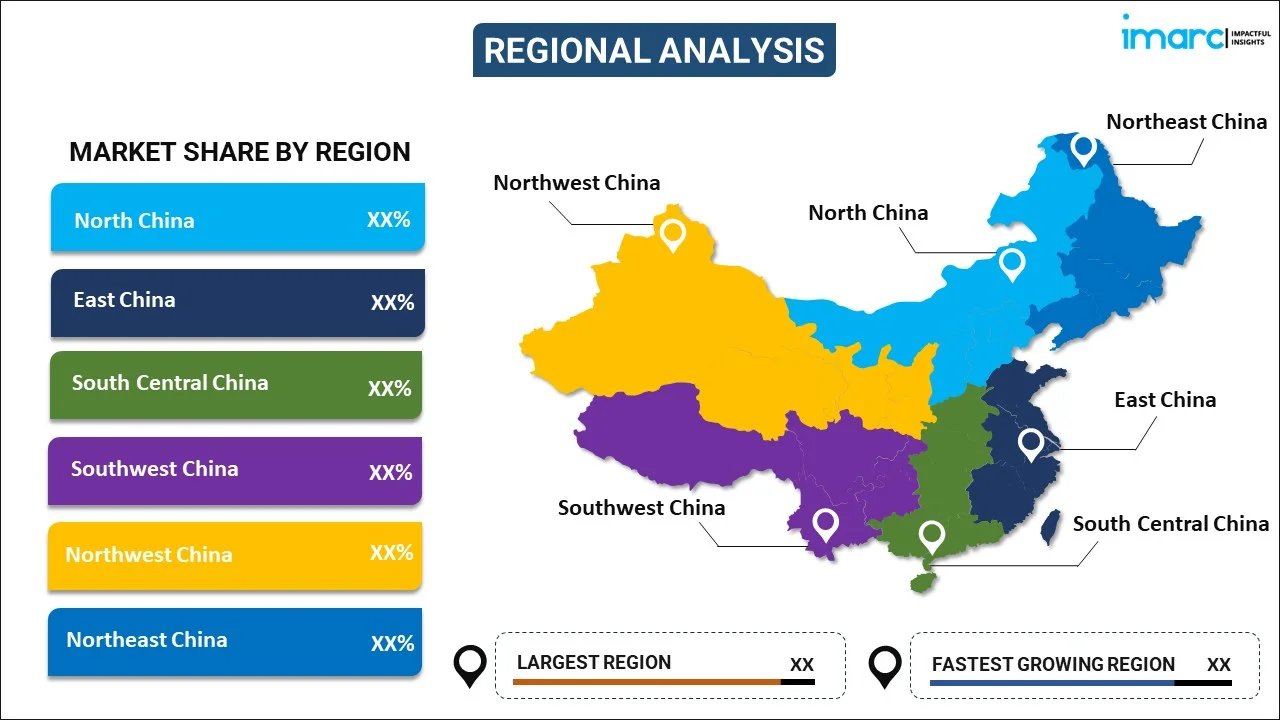
China Fruit Juice Market Report by Product Type (100% Fruit Juice, Nectars, Juice Drinks, Concentrates, Powdered Juice, and Others), Flavor (Orange, Apple, Mango, Mixed Fruit, and Others), Distribution Channel (Supermarkets and Hypermarkets, Convenience Stores, Specialty Food Stores, Online Retail, and Others), and Region 2025-2033
China Fruit Juice Market Overview:
The China fruit juice market is projected to exhibit a growth rate (CAGR) of 5.30% during 2025-2033. The market is experiencing robust growth driven by rising health awareness, urbanization, and expanding retail infrastructure, with a shift towards premium, health-oriented products leading to consumer preferences.
|
Report Attribute
|
Key Statistics
|
|---|---|
|
Base Year
|
2024 |
|
Forecast Years
|
2025-2033
|
|
Historical Years
|
2019-2024
|
| Market Growth Rate (2025-2033) | 5.30% |
China Fruit Juice Market Trends:
Shift Towards Healthier Lifestyles and Rising Health Awareness
A significant factor driving the fruit juice market in China is the growing consumer awareness regarding health and wellness, coupled with a shift towards healthier dietary choices. As Chinese consumers become more health-conscious, there is an increasing preference for beverages that offer nutritional benefits, such as fruit juices over carbonated drinks. The rising prevalence of lifestyle diseases such as obesity and diabetes has also prompted a more health-conscious behavior among consumers. This trend is supported by government initiatives promoting healthier living, which encourage the consumption of natural and less processed foods and beverages. Moreover, the younger demographics, particularly millennials and Generation Z, are more inclined towards products that not only provide health benefits but also align with their fast-paced lifestyles. Consequently, manufacturers are focusing on innovation in product offerings, such as fortified juices with added vitamins, minerals, and herbal supplements to cater to these evolving consumer preferences. The market has seen an increase in the demand for premium juice products, which are perceived as being more natural and healthier.
Urbanization and Expansion of Retail Infrastructure:
The market for fruit juice in China has been accelerated by the increasing rate of urbanization necessary for the changes in the supply chain and customers’ buying habits. Since more people are moving to urban areas there is a high chance to come across various types of fruit juices and new and modern formats of stores like supermarkets, hypermarkets, and convenience stores where one can not only get different brands of fruit juices but also frequent and easy access. These retail channels have been expanded thus increasing the accessibility of the fruit juice products in the market to the normal consumer. Apart from this, advanced features of internet sales in China have changed the structure of retail stores, thus customers may order fruit juices online conveniently at reasonable prices. Availability has also been another key factor where manufacturers of juices have flooded the markets with products, thus expanding the coverage and absorption of their fruit juices in all categories and regions. Increased consumer consciousness toward personal health and well-being is also a factor that puts pressure on the growth of RTD fruit juice popularity due to the convenience of the product in relation to the non-urban consumer lifestyle.
China Fruit Juice Market News:
- The Coca-Cola Company and eight bottling partners from around the world today announced the closing of a new, $137.7 million venture capital fund focusing on sustainability investments. Greycroft, a seed-to-growth venture capital firm, will manage the Greycroft Coca-Cola System Sustainability Fund. The fund is the first of its kind for Greycroft, which invests in enterprise and consumer solutions across life cycles and industries.
- On May 15, 2024, Capri Sun announced they are launching a 96 oz. Multi-Serve bottle of its best-selling Fruit Punch flavor—its first major product innovation in nearly a decade, just in time for summer. Between 2020 and 2023, 76% of suggestions to Capri Sun’s call center requested larger serving sizes.
China Fruit Juice Market Segmentation:
IMARC Group provides an analysis of the key trends in each segment of the market, along with forecasts at the country level for 2025-2033. Our report has categorized the market based on product type, flavor, and distribution channel.
Product Type Insights:

- 100% Fruit Juice
- Nectars
- Juice Drinks
- Concentrates
- Powdered Juice
- Others
The report has provided a detailed breakup and analysis of the market based on the product type. This includes 100% fruit juice, nectars, juice drinks, concentrates, powdered juice, and others.
Flavor Insights:
- Orange
- Apple
- Mango
- Mixed Fruit
- Others
A detailed breakup and analysis of the market based on the flavor have also been provided in the report. This includes orange, apple, mango, mixed fruit, and others.
Distribution Channel Insights:
- Supermarkets and Hypermarkets
- Convenience Stores
- Specialty Food Stores
- Online Retail
- Others
The report has provided a detailed breakup and analysis of the market based on the distribution channel. This includes supermarkets and hypermarkets, convenience stores, specialty food stores, online retail, and others.
Regional Insights:

- North China
- East China
- South Central China
- Southwest China
- Northwest China
- Northeast China
The report has also provided a comprehensive analysis of all the major regional markets, which include North China, East China, South Central China, Southwest China, Northwest China, and Northeast China.
Competitive Landscape:
The market research report has also provided a comprehensive analysis of the competitive landscape. Competitive analysis such as market structure, key player positioning, top winning strategies, competitive dashboard, and company evaluation quadrant has been covered in the report. Also, detailed profiles of all major companies have been provided.
China Fruit Juice Market Report Coverage:
| Report Features | Details |
|---|---|
| Base Year of the Analysis | 2024 |
| Historical Period | 2019-2024 |
| Forecast Period | 2025-2033 |
| Units | Billion US$ |
| Scope of the Report | Exploration of Historical and Forecast Trends, Industry Catalysts and Challenges, Segment-Wise Historical and Predictive Market Assessment:
|
| Product Types Covered | 100% Fruit Juice, Nectars, Juice Drinks, Concentrates, Powdered Juice, Others |
| Flavors Covered | Orange, Apple, Mango, Mixed Fruit, Others |
| Distribution Channels Covered | Supermarkets and Hypermarkets, Convenience Stores, Specialty Food Stores, Online Retail, Others |
| Regions Covered | North China, East China, South Central China, Southwest China, Northwest China, Northeast China |
| Customization Scope | 10% Free Customization |
| Post-Sale Analyst Support | 10-12 Weeks |
| Delivery Format | PDF and Excel through Email (We can also provide the editable version of the report in PPT/Word format on special request) |
Key Questions Answered in This Report:
- How has the China fruit juice market performed so far and how will it perform in the coming years?
- What has been the impact of COVID-19 on the China fruit juice market?
- What is the breakup of the China fruit juice market on the basis of product type?
- What is the breakup of the China fruit juice market on the basis of flavor?
- What is the breakup of the China fruit juice market on the basis of distribution channel?
- What are the various stages in the value chain of the China fruit juice market?
- What are the key driving factors and challenges in the China fruit juice?
- What is the structure of the China fruit juice market and who are the key players?
- What is the degree of competition in the China fruit juice market?
Key Benefits for Stakeholders:
- IMARC’s industry report offers a comprehensive quantitative analysis of various market segments, historical and current market trends, market forecasts, and dynamics of the China fruit juice market from 2019-2033.
- The research report provides the latest information on the market drivers, challenges, and opportunities in the China fruit juice market.
- Porter's five forces analysis assist stakeholders in assessing the impact of new entrants, competitive rivalry, supplier power, buyer power, and the threat of substitution. It helps stakeholders to analyze the level of competition within the China fruit juice industry and its attractiveness.
- Competitive landscape allows stakeholders to understand their competitive environment and provides an insight into the current positions of key players in the market.
Need more help?
- Speak to our experienced analysts for insights on the current market scenarios.
- Include additional segments and countries to customize the report as per your requirement.
- Gain an unparalleled competitive advantage in your domain by understanding how to utilize the report and positively impacting your operations and revenue.
- For further assistance, please connect with our analysts.
 Inquire Before Buying
Inquire Before Buying
 Speak to an Analyst
Speak to an Analyst
 Request Brochure
Request Brochure
 Request Customization
Request Customization




.webp)




.webp)












